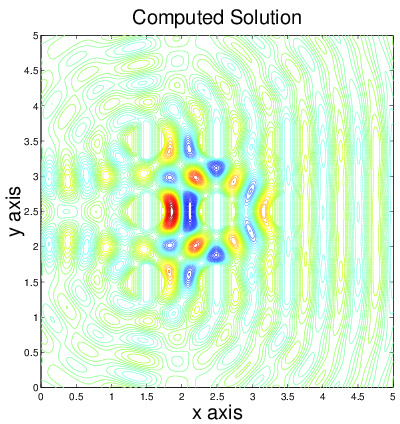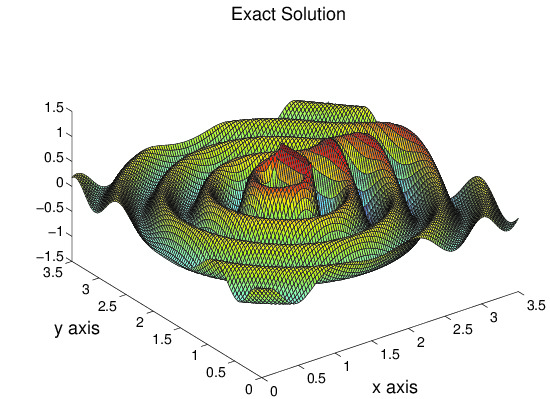| Home | Research | Publications | Advising & Students | Teaching |
Bokil Computational Mathematics Research Group


Current Research ProjectsComputational Magnetohydrodynamics (MHD) and Micromagnetics
Collaborators: Nathan Gibson (OSU-Mathematics), Pallavi Dhagat (OSU-EECS), Vitaliy Gyrya (LANL), Giamarco Manzini (LANL), Rigel Woodside (NETL) Current Funding NSF DMS #2012882: Computational and Multi-Scale Methods for Nonlinear Electromagnetic Models in Plasmas and Nanocomposites in collaboration with Drs Nathan Gibson and Pallavi Dhagat, both at Oregon State.
Past Funding National Energy Technology Laboratory (NETL), Albany, OR Summary:This project is an inter-disciplinary collaboration involving mathematical modeling, computational simulation and experimental data for accelerating the design of advanced electromagnetic nanocomposite materials as well as alternative power generators. Nanocomposites, made of ferromagnetic nanoparticles in a dielectric, non-magnetic matrix, offer unparalleled opportunities for innovation in electromagnetic materials. The ability to predict electromagnetic material properties as a function of size, shape and concentration of inclusions in the host matrix, from computational simulations of physics-based models, will crucially aid in the digital fabrication of nanocomposites. These advances in design will enable applications including microwave frequency antennas and gradient refractive index lenses, printed electronic circuits and systems, to name a few. This objective is related to the Materials Genome Initiative's mission to accelerate materials innovation via computation. A second objective involves Magnetohydrodynamic (MHD) power generation, which is potentially a significant component of a secure U.S. energy portfolio. The lack of moving parts in an MHD power generator increases the overall efficiency of the power plant and potentially decreases carbon emissions significantly. Computational simulations of physics-based models will aid in the optimal design of these thermally efficient energy systems. The models we consider are also essential to correctly modeling solar flares which can trigger geomagnetic storms disrupting power and communications costing millions of dollars in losses. Thus our techniques will advance applications in astrophysics, space weather prediction and clean energy systems, among others. The major goal of this project is to develop novel numerical discretizations and computational multiscale electromagnetic models incorporating uncertainties in nonlinear material properties. The resulting methods will enable optimal design strategies in the applications discussed above. We will validate the effectiveness of our methods using experimental data provided by our collaborators, which will also be used to calibrate statistical descriptions of uncertainties. One area of research involves a model-driven robust design methodology for a magnetic nanocomposite material with the desired properties critically needed for advanced devices. A second area, involves nonlinear models for magnetic fields in plasma. The PIs each have demonstrated records of integration of research into education and are dedicated educators committed to recruiting minorities and creating welcoming environments. The PIs will train three doctoral students on theoretical, computational and experimental aspects of this interdisciplinary project. The partnerships with government labs and industry will provide internship opportunities for the graduate students.
Computational Photonics and Optics
Compatible Discretizations for Maxwell Models in Nonlinear OpticsCollaborators: Yingda Cheng (MSU), Fengyan Li (RPI)Current Funding NSF Computational Mathematics Grant #1720116 OP: Collaborative Research: Compatible Discretizations for Maxwell Models in Nonlinear Optics .
Past Funding ICERM, Collborate@ICERM, June 6-10, 2016 . Nonlinear optics is the study of the behavior of light in nonlinear media. This field has developed into a significant branch of physics since the introduction of intense lasers with high peak powers. Compared with the huge amount of literature on simulations of Maxwell's equations in linear optical media, developing mathematically well-understood computational tools for space-time models in nonlinear optical media is relatively less tackled by the computational math community. Major advancement in this aspect can provide the scientific community reliable and accurate tools to simulate and to understand nonlinear optical phenomena, which hence can be better harnessed for practical applications. The objective of the collaborative research program is to make significant advances in the understanding and simulations of Maxwell models in nonlinear optics with the aim of: (1) providing robust simulation tools for the nonlinear optics community, (2) developing novel mathematical and numerical techniques that are specifically tailored for different types of nonlinear models. The specific technical aspect includes the development of energy-stable time discretizations as well as two classes of spatial discretizations, discontinuous Galerkin methods and mimetic finite difference methods, for the propagation of electromagnetic waves in nonlinear (dispersive) optical media. Both macroscopic phenomenological and microscopic quantum descriptions will be considered for modeling the nonlinear material responses. Applications involving femtosecond soliton propagation, harmonic generation, self focusing, among others will be simulated and compared to existing time domain methods. This collaborative program is strengthened by a cohesive research plan that relies on the complementary expertise of each principal investigator. The educational components are integrated through the training of graduate students. Mimetic Finite Difference Methods and Virtual Element Methods for Maxwell's EquationsCollaborators: Vitaliy Gyrya (LANL), Giamarco Manzini (LANL)Students Involved : Sebastian Naranjo Alvarez (PhD 2021), Duncan McGregor (PhD 2016) Funding National Science Foundation, Los Alamos National Laboratory. We study a novel strategy for minimizing the numerical dispersion error in edge discretizations of Maxwell's equations on square and rectangular meshes based on the mimetic finite difference (MFD) method. We call this strategy M-adaptation. We have recently constructed M-adapted methods that exhibit fourth order numerical dispersion for Maxwell's equations in non-dispersive dielectrics. Our current work involves the non-trivial extension of the M-adapted method to Maxwell's equations in linear and nonlinear dispersive media and metamaterials. Grant Funding
Past Funding
|
Links: |